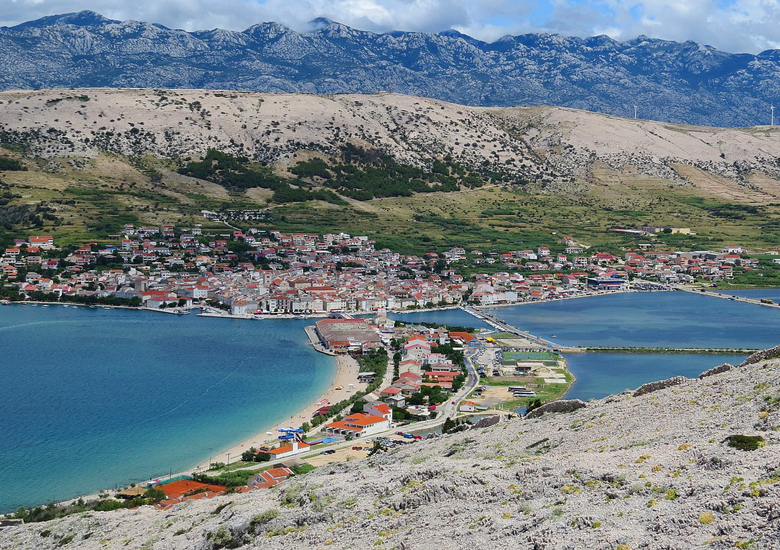Pag is a Croatian island in the northern Adriatic Sea. It is the fifth-largest island of the Croatian coast, and the one with the longest coastline. In the 2011 census, the population of the island was 9,059. There are two towns on the island, Pag and Novalja, as well as many smaller villages and tourist places. Pag is the only Croatian island that is administratively divided between two counties. Its northern part belongs to Lika-Senj County, while the central and southern parts belong to Zadar County
Geography : Pag belongs to the north Dalmatian archipelago and it extends northwest-southeast along the coast, forming the Velebit channel. The island has an area of 284.56 square kilometres (109.87 sq mi) and the coastline is 269.2 kilometres (167.27 mi). It is around 60 kilometres (37 miles) long (from northwest to southeast), and between 2 and 10 kilometres (1.2 and 6.2 miles) wide. The southwestern coast of the island is low (including the Pag Bay with the large Caska cove), and the northwestern is steep and high (including Stara Novalja Bay). Most of the island is rocky smaller areas are covered with Mediterranean shrubs. The southeast of the island contains karst lakes Velo Blato and Malo Blato. The island’s highest peak, at 349 metres (1,145 feet), is Sveti Vid (St Vitus).
Grapes, vegetables and fruit are grown in the valleys and fields. The northern area of the Lun peninsula is mostly under olive groves. Most communities on the island are connected by a road. A 300 m (980 ft)-long arch bridge connects the southern part of the island to the mainland. The Prizna–Zigljen ferry connects the northern part of the island to the mainland. The island has two towns, Pag and Novalja, and many smaller villages and communities, including Lun, Stara Novalja, Gajac, Kolan, Metajna, Dinjiska, Povljana and others. The island is divided between two counties, with Novalja, Stara Novalja, Lun and Metajna being part of the northern Lika-Senj County, and the remainder of the island south of an isthmus at Gajac, including the town of Pag, being part of the southern Zadar County.
History : The earliest settlers on the island were an Illyrian tribe that came to the region in the Bronze Age; traces of their settlement can still be seen around Pag. In the 1st century BC, the Romans took possession, and have left numerous archeological and cultural artifacts. The Croats arrived in the 7th century along with the great migration and settled in the area. The island was for some time under the rule of the Croatian kingdom. Yet the island was always fought over, and in the 11th and 12th centuries was divided between the communities of Rab (Arbe) and of Zadar (Zara).
From the 12th to 14th centuries, Pag, along with other Dalmatian islands and towns, was fiercely contested between the Republic of Venice and the Croatian-Hungarian rulers. For four centuries from the start of the 15th century, it was held by Venice, until Venice lost its independence in 1797. Austria and France then fought over Dalmatia with victory going to the Austrians.
The island passed from Austria-Hungary to the Kingdom of Yugoslavia after World War I, and then to the Independent State of Croatia (1941–45), under whose rule the island served as a concentration camp, primarily for Serbs but also Jews, Roma, and Croatian anti-fascists. After the Second World War it returned to Yugoslavia and, after the dissolution of Yugoslavia in 1991, the island became part of the Republic of Croatia.
Access : Coordinates : 44.483333, 14.966667 / Getting to Pag by bus Several cities connect to the island with bus lines : by bus from Rijeka , Zadar , Split , Zagreb ,
, Getting to Pag by catamaran from Rijeka : There is a daily, year-round catamaran service from Rijeka to Novalja (that stops on Rab along the way) run by Jadrolinija. Journey time is two and half hours , Most travelers come in through highway A1 Zagreb-Split-Ravca (next to Ploce and heading Dubrovnik). The highway is modern, fast and safe.By plane : Split and Dubrovnik have international airports and seaports.
Attractions : Dalmatia-Dubrovnik Region-Emerald beauty of the south : Peljesac peninsula , Island of Korcula , Una Mamea Park Arboretum
Cista Beach , Church of the Assumption , Pag Lace Gallery , Bosana Beach , Simuni Beach . Activities : Canoe safari on the river Zrmanja , Excursion Vodice archipelago sailing , Excursion Discover National Park Krka and Sibenik Tour.
Go next : Rab / Cres / Ilovik/ Losinj / Silba

